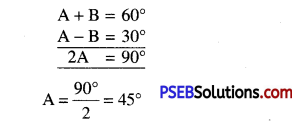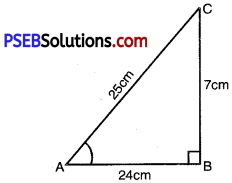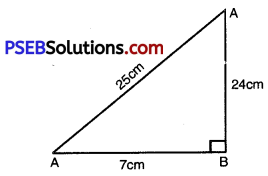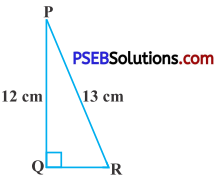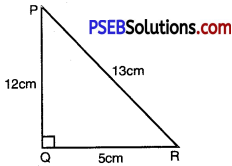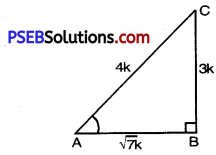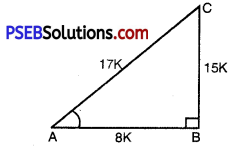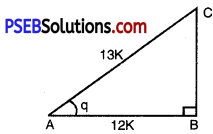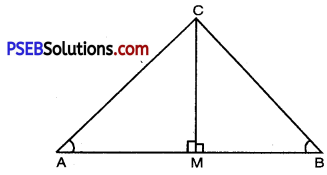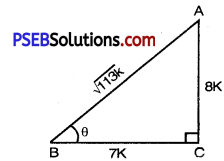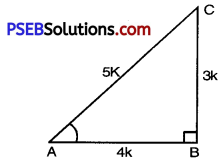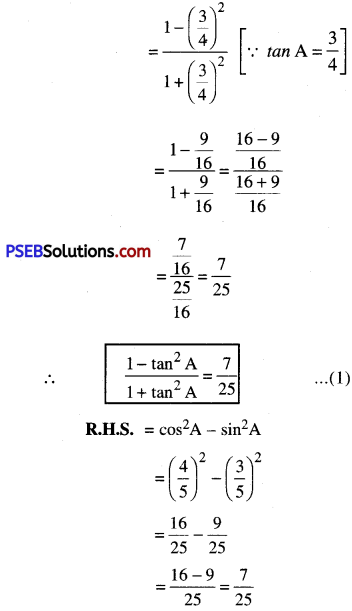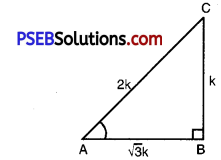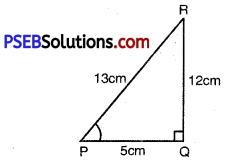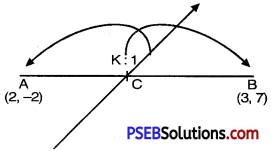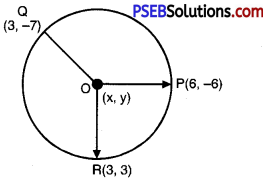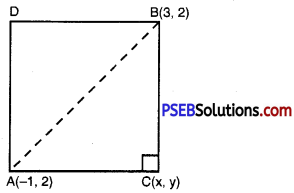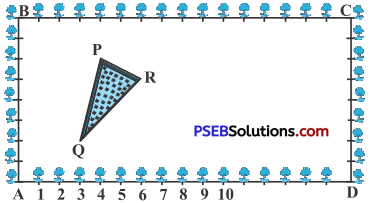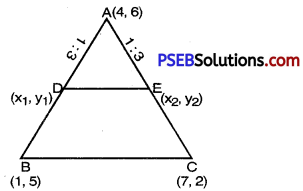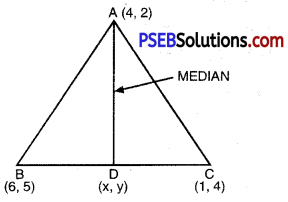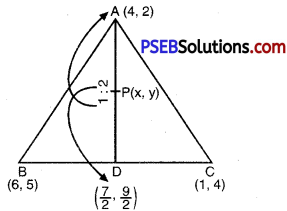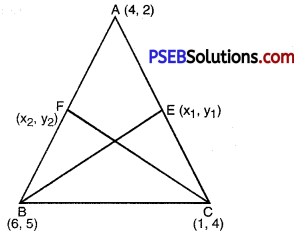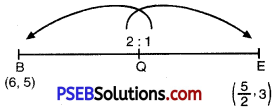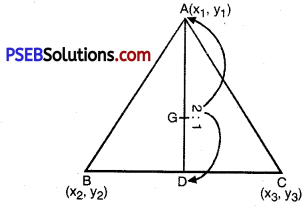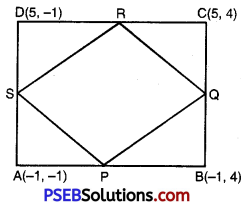Punjab State Board PSEB 10th Class Maths Book Solutions Chapter 8 Introduction to Trigonometry Ex 8.4 Textbook Exercise Questions and Answers.
PSEB Solutions for Class 10 Maths Chapter 8 Introduction to Trigonometry Ex 8.4
Question 1.
Express the trigonometric ratios of sin A, sec A and tan A in terms of cot A.
Solution:
By using Identity,
cosec2 A – cot2 A = 1
⇒ cosec2 A = 1 + cot2 A
⇒ (cosec A)2 = cot2 A + 1
⇒ \(\left(\frac{1}{\sin A}\right)^{2}\) = cot2 A + 1
⇒ (sin A)2 = \(\frac{1}{\cot ^{2} \mathrm{~A}+1}\)
⇒ sin A = ± \(\frac{1}{\sqrt{\cot ^{2} \mathrm{~A}+1}}\)
We reject negative values of sin A for acute angle A.
Therefore, sin A = \(\frac{1}{\sqrt{\cot ^{2} A+1}}\)
By using identity,
sec2 A – tan2 A = 1
⇒ sec2 A = 1 + tan2 A
= 1 + \(\frac{1}{\cot ^{2} A}\)
= \(\frac{\cot ^{2} A+1}{\cot ^{2} A}\)
⇒ sec A = \(\sqrt{\frac{\cot ^{2} A+1}{\cot ^{2} A}}\)
tan A = \(\frac{1}{\cot A}\).
![]()
Question 2.
Write all the other trigonometric ratios of ∠A in terms of sec A.
Solution:
By using Identity
sin2 A + cos2 A = 1
⇒ sin2 A = 1 – cos2 A
= 1 – \(\frac{1}{\sec ^{2} \cdot A}\) = \(\frac{\sec ^{2} A-1}{\sec ^{2} A}\)
⇒ (sin A)2 = \(\frac{\sec ^{2} A-1}{\sec ^{2} A}\)
⇒ sin A = ± \(\sqrt{\frac{\sec ^{2} A-1}{\sec ^{2} A}}\)
[Reject – ve sign for acute angle A]
⇒ sin A = ± \(\sqrt{\frac{\sec ^{2} A-1}{\sec ^{2} A}}\)
cos A = \(\frac{1}{\sec A}\)
1 + tan2 A = sec2 A
tan2 A = sec2 A – 1
(tan A)2 = sec2 A – 1
⇒ tan A = ± \(\sqrt{\sec ^{2} A-1}\)
[Reject – ve sign for acute angle A]
i.e., tan A = \(\sqrt{\sec ^{2} A-1}\)
cosec A = \(\frac{1}{\sin A}=\frac{1}{\sqrt{\sec ^{2} A-1}}\)
= \(\frac{\sec A}{\sqrt{\sec ^{2} A-1}}\)
cot A = \(\frac{1}{\tan A}=\frac{1}{\sqrt{\sec ^{2} A-1}}\).
Question 3.
Evaluate:
(i) \(\frac{\sin ^{2} 63^{\circ}+\sin ^{2} 27^{\circ}}{\cos ^{2} 17^{\circ}+\cos ^{2} 73^{\circ}}\)
(ii) sin 25° cos 65° + cos 25° sin 65°.
Solution:
(i) \(\frac{\sin ^{2} 63^{\circ}+\sin ^{2} 27^{\circ}}{\cos ^{2} 17^{\circ}+\cos ^{2} 73^{\circ}}\)
= \(\frac{\left\{\sin \left(90^{\circ}-27^{\circ}\right)+\sin ^{2} 27^{\circ}\right\}}{\cos ^{2} 17^{\circ}+\left\{\cos \left(90^{\circ}-17^{\circ}\right)\right\}^{2}}\)
[∵ sin(90 – θ) = cos θ and cos (90 – θ) = sin θ]
= \(\frac{\left\{\cos 27^{\circ}\right\}^{2}+\sin ^{2} 27^{\circ}}{\cos ^{2} 17^{\circ}+\left\{\sin 17^{\circ}\right\}^{2}}\)
= \(\frac{\cos ^{2} 27^{\circ}+\sin ^{2} 27^{\circ}}{\cos ^{2} 17^{\circ}+\sin ^{2} 17^{\circ}}\)
= \(\frac{1}{1}\) = 1.
![]()
(ii) sin 25° cos 65° + cos 25° sin 65°
= sin 25° × cos (90° – 25°)
+ cos 25° × sin (90° – 25°)
[∵ cos (90° – θ) = sin θ
sin(90° – θ) = cos θ].
= sin 25° × sin 25° + cos 25° × cos 25°
= sin2 25° + cos2 25° = 1.
Question 4.
Choose the correct option. Justify your choice:
(i) 9 sec2 A – 9 tan2 A =
(A) 1
(B) 9
(C) 8
(D) 0.
(ii) (1 + tan θ + sec θ) (1 + cot θ – cosec θ) =
(A) θ
(B) 1
(C) 2
(D) – 1.
(iii) (sec A + tan A) (1 – sin A) =
(A) sec A
(B) sin A
(C) cosec A
(D) cos A.
(iv) \(\frac{1+\tan ^{2} A}{1+\cot ^{2} A}\) =
(A) sec2A
(B) – 1
(C) cot2 A
(D) tan2 A.
Solution:
(i) Consider, 9 sec2 A – 9 tan2 A
= 9 (sec2 A – tan2 A)
= 9 × 1 = 9.
Option (B) is correct.
![]()
(ii) Consider, (1 + tan θ + sec θ) (1 + cot θ – cosec θ)
= \(\left\{1+\frac{\sin \theta}{\cos \theta}+\frac{1}{\cos \theta}\right\} \times\left\{1+\frac{\cos \theta}{\sin \theta}-\frac{1}{\sin \theta}\right\}\)
= \(\left\{\frac{\cos \theta+\sin \theta+1}{\cos \theta}\right\} \times\left\{\frac{\sin \theta+\cos \theta+1}{\sin \theta}\right\}\)
= \(\begin{array}{r}
\{(\cos \theta+\sin \theta)+1\} \\
\times\{(\cos \theta+\sin \theta)-1\} \\
\hline \cos \theta \times \sin \theta
\end{array}\)
= \(\frac{(\cos \theta+\sin \theta)^{2}-(1)^{2}}{\cos \theta \times \sin \theta}\)
[∵ (a + b) (a – b) = a2 – b2]
= \(\frac{\cos ^{2} \theta+\sin ^{2} \theta+2 \cos \theta \sin \theta-1}{\cos \theta \times \sin \theta}\)
= \(\frac{1+2 \cos \theta \sin \theta-1}{\cos \theta \sin \theta}\) = 2.
Option (C) is correct.
(iii) Consider, (sec A + tan A) (1 – sin A)
= \(\left(\frac{1}{\cos A}+\frac{\sin A}{\cos A}\right)\) × (1 – sin A)
= \(\frac{(1+\sin A)}{\cos A}\) × (1 – sin A)
= \(\frac{(1+\sin A)(1-\sin A)}{\cos A}\)
= \(\frac{(1)^{2}-(\sin A)^{2}}{\cos A}=\frac{1-\sin ^{2} A}{\cos A}=\frac{\cos ^{2} A}{\cos A}\)
[∵ cos2 A = 1 – sin2 A]
= cos A.
Option (D) is correct.
![]()
(iv) Consider, \(\frac{1+\tan ^{2} A}{1+\cot ^{2} A}\)
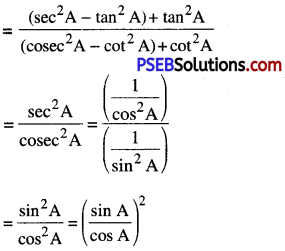
= tan2 A.
Option (D) is correct.
Question 5.
Prove the following Identities, where the angles involved are acute angles for which the expressions are defined.
(i) (cosec θ – cot θ) = \(\frac{1-\cos \theta}{1+\cos \theta}\)
(ii) \(\frac{\cos A}{1+\sin A}+\frac{1+\sin A}{\cos A}\) = 2 sec A.
(iii) \(\frac{\tan \theta}{1+\cot \theta}+\frac{\cot \theta}{1-\tan \theta}\) = 1 + sec θ cosec θ
[Hint : Write the expression in terms of sin θ and cos θ]
(iv) \(\frac{1+\sec A}{\sec A}=\frac{\sin ^{2} A}{1-\cos A}\)
[Hint: Simplify L.H.S. and R.H.S. separately]
(v) \(\frac{\cos A-\sin A+1}{\cos A+\sin A-1}\) using the identity cosec2 A = 1 + cot2 A.
(vi) \(\sqrt{\frac{1+\sin A}{1-\sin A}}\) = sec A + tan A
(vii) \(\frac{\sin \theta-2 \sin ^{3} \theta}{2 \cos ^{3} \theta-\cos \theta}\) = tan θ
(viii) (sin A + cosec A)2 + (cos A + sec A)2 = 7 + tan2 A + cot2 A.
(ix) (cosec A – sin A) (sec A – cos A) = \(\frac{1}{\tan A+\cot A}\)
[Hint : Simplify L.H.S. and R.H.S. separately]
(x) \(\left(\frac{1+\tan ^{2} A}{1+\cot A^{2}}\right)=\left(\frac{1-\tan A}{1-\cot A}\right)^{2}\) = tan2 A.
![]()
Solution:
(i) L.H.S. = (cosec θ – cot θ)2
= \(\left\{\frac{1}{\sin \theta}-\frac{\cos \theta}{\sin \theta}\right\}^{2}\)
= \(\left(\frac{1-\cos \theta}{\sin \theta}\right)^{2}=\frac{(1-\cos \theta)^{2}}{\sin ^{2} \theta}\)
Using identity, sin2 θ + cos2 θ = 1
⇒ sin2 θ = 1 – cos2 θ
= \(\frac{(1-\cos \theta)^{2}}{1-\cos ^{2} \theta}\)
= \(\)
[∵ a2 – b2 = (a + b) (a – b)]
= \(\)
∴ L.H.S. = R.H.S.
Hence, (cosec θ – cot θ)2 = \(\frac{1-\cos \theta}{1+\cos \theta}\)
(ii) L.H.S. = \(\frac{\cos A}{1+\sin A}+\frac{1+\sin A}{\cos A}\)
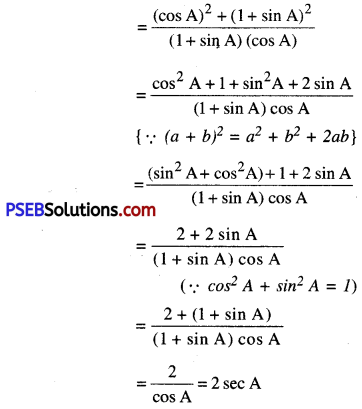
= \(\frac{2}{\cos A}\) = cos A
∴L.H.S. = R.H.S.
Hence, \(\frac{\cos A}{1+\sin A}+\frac{1+\sin A}{\cos A}\) = 2 sec A.
![]()
(iii) L.H.S. = \(\frac{\tan \theta}{1+\cot \theta}+\frac{\cot \theta}{1-\tan \theta}\) = 1 + sec θ cosec θ
= \(\frac{\left(\frac{\sin \theta}{\cos \theta}\right)}{\left(1-\frac{\cos \theta}{\sin \theta}\right)}+\frac{\left(\frac{\cos \theta}{\sin \theta}\right)}{\left(1-\frac{\sin \theta}{\cos \theta}\right)}\)
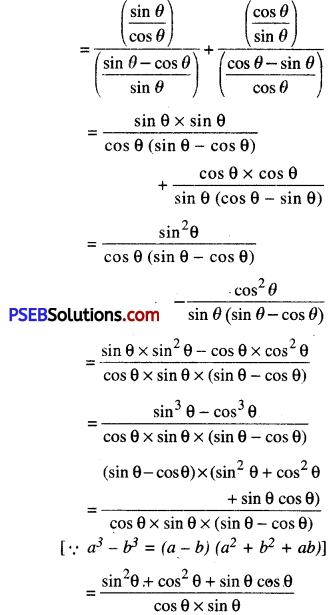
= \(\frac{1+\sin \theta \cos \theta}{\cos \theta \sin \theta}=\frac{1}{\cos \theta \sin \theta}+1\)
= 1 + \(\left(\frac{1}{\cos \theta}\right)\left(\frac{1}{\sin \theta}\right)\) = 1 + sec θ cosec θ
∴L.H.S. = R.H.S.
Hence, \(\frac{\tan \theta}{1+\cot \theta}+\frac{\cot \theta}{1-\tan \theta}\) = 1 + sec θ cosec θ
(iv) L.H.S. = \(\frac{1+\sec A}{\sec A}=\frac{\sin ^{2} A}{1-\cos A}\)
= \(\frac{1+\frac{1}{\cos A}}{\frac{1}{\cos A}}\)
= 1 + cos A …………….(1)
R.H.S = \(\frac{\sin ^{2} A}{1-\cos A}\)
(∵ 1 – cos2 A = sin2 A.)
= \(\frac{1-\cos ^{2} A}{1-\cos A}\)
= \(\frac{(1+\cos A)(1-\cos A)}{(1-\cos A)}\)
= 1 + cos A. …………….(2)
From (1) and (2) it is clear that
∴ L.H.S. = R.H.S.
Hence, \(\frac{1+\sec A}{\sec A}=\frac{\sin ^{2} A}{1-\cos A}\).
![]()
(v) L.H.S. = \(\frac{\cos A-\sin A+1}{\cos A+\sin A-1}\) using the identity cosec2 A
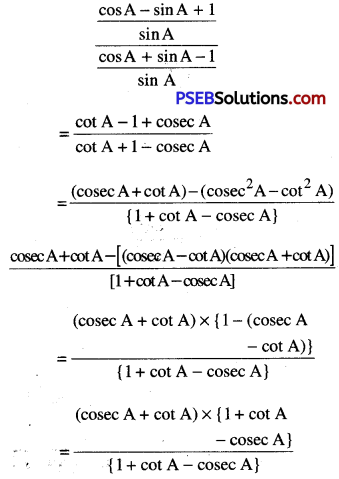
= cosec A + cot A
= R.H.S
∴ L.H.S. = R.H.S.
Hence, \(\frac{\cos A-\sin A+1}{\cos A+\sin A-1}\) using the identity cosec2 A = 1 + cot2 A.
(vi) L.H.S. = \(\sqrt{\frac{1+\sin A}{1-\sin A}}\)
= \(\sqrt{\frac{(1+\sin A)(1+\sin A)}{(1-\sin A)(1+\sin A)}}\)
= \(\sqrt{\frac{(1+\sin A)^{2}}{(1)^{2}-(\sin A)^{2}}}\)
= \(\sqrt{\frac{(1+\sin A)^{2}}{1-\sin ^{2} A}}=\sqrt{\frac{(1+\sin A)^{2}}{\cos ^{2} A}}\)
= \(\frac{1+\sin A}{\cos A}=\frac{1}{\cos A}+\frac{\sin A}{\cos A}\)
= sec A + tan A
∴ L.H.S. = R.H.S.
Hence, \(\sqrt{\frac{1+\sin A}{1-\sin A}}\) = sec A + tan A.
![]()
(vii) L.H.S. = \(\frac{\sin \theta-2 \sin ^{3} \theta}{2 \cos ^{3} \theta-\cos \theta}\)
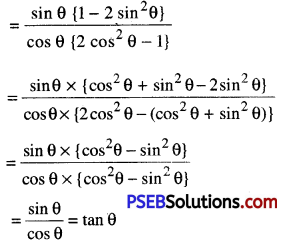
∴ L.H.S. = R.H.S.
Hence, \(\frac{\sin \theta-2 \sin ^{3} \theta}{2 \cos ^{3} \theta-\cos \theta}\) = tan θ
(viii) L.H.S. = (sin A + cosec A)2 + (cos A + sec A)2
= (sin2 A + cosec2 A + 2 sin A × cosec A) + {cos2 A + sec2 A
+ 2 cos A × sec A)
= [sin2 A + co2 A + 2sin A × \(\frac{1}{\sin A}\)] + [cos2 A + sec2 A + 2 cosA × \(\frac{1}{\cos A}\)]
= (sin2 A + cosec2 A + 2) + (cos2 A + sec2 A + 2)
= 2 + 2 + (sin2 A + cos2 A) + sec2 A + cosec2 A
= 2 + 2 + 1 + 1 + tan2 A + 1 + cot2 A
= 7 tan2 A + cot2 A
∴ L.H.S. = R.H.S.
Hence, (sin A + cosec A)2 + (cos A + sec A)2 = 7 + tan2 A + cot2 A.
![]()
(ix) L.H.S. = (cosec A – sin A) (sec A – cos A)
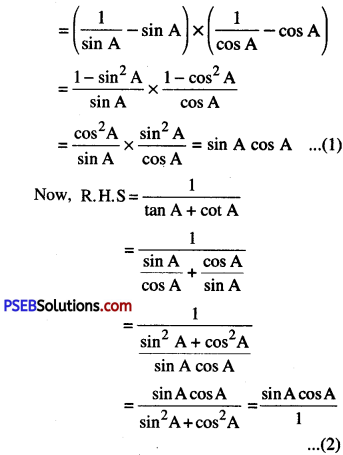
From (1) and (2), it is clear that
L.H.S. = R.H.S.
Hence, (cosec A – sin A) (sec A – cos A) = \(\frac{1}{\tan A+\cot A}\)
(x) \(\left(\frac{1+\tan ^{2} A}{1+\cot A^{2}}\right)\)
(∵ 1 + tan2 A = sec2 A
and 1 + cot2 A = cosec2 A)
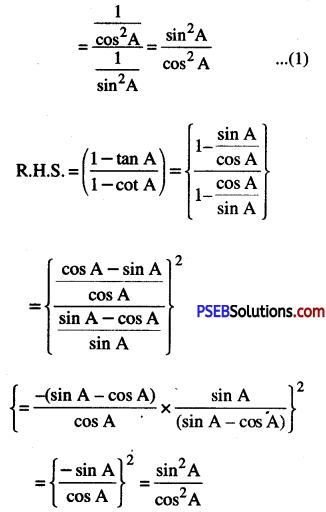
From (1) and (2), it is clear that
LH.S. = R.H.S.
Hence, \(\left(\frac{1+\tan ^{2} A}{1+\cot A^{2}}\right)=\left(\frac{1-\tan A}{1-\cot A}\right)^{2}\) = tan2 A.
![]()


